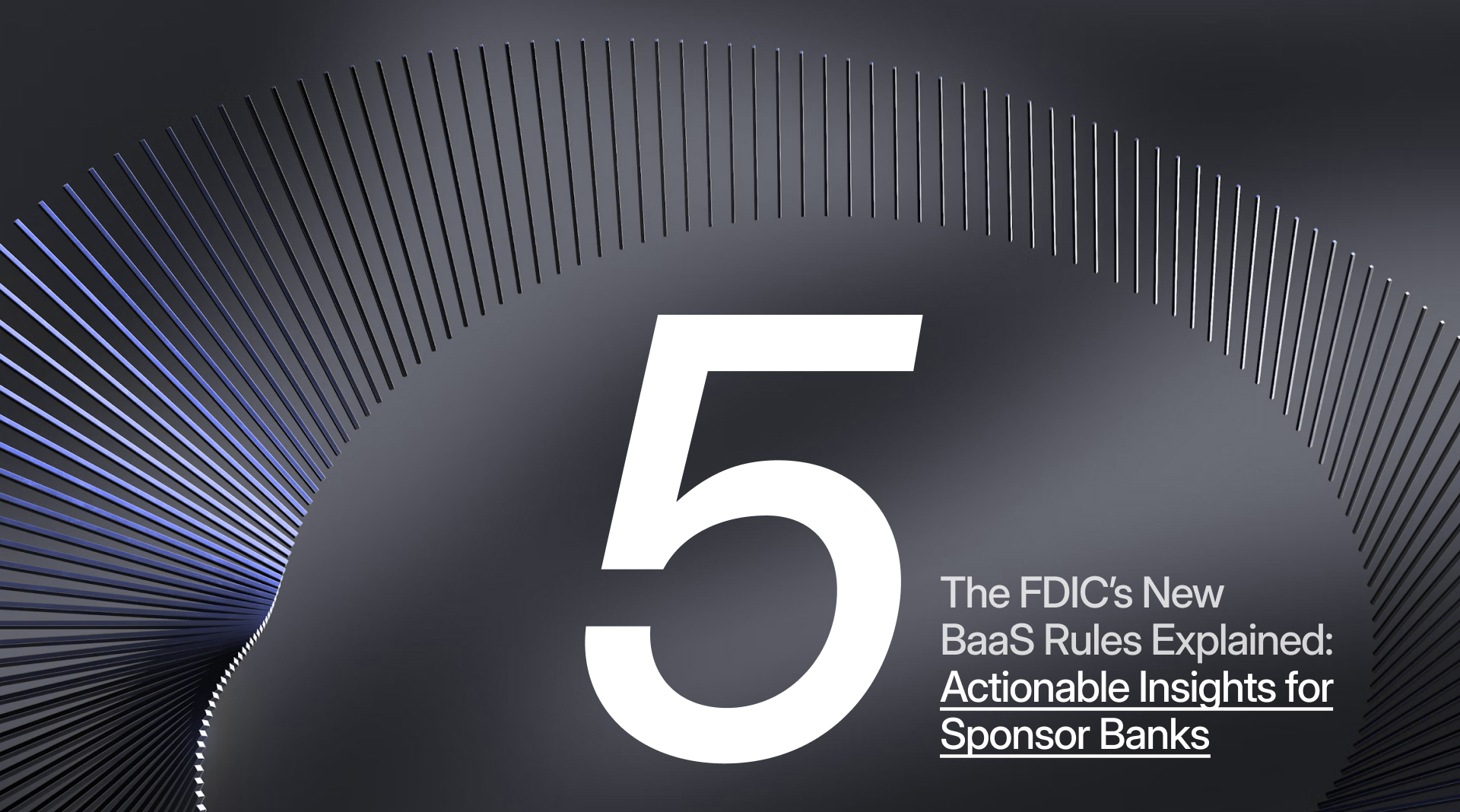
The FDIC’s New BaaS Rules Explained: 5 Actionable Insights for Sponsor Banks

This article was originally published in BAI.
For some time now, Banking as a Service (BaaS) has been an important part of a bank’s toolkit. On one side, it creates new growth through fintech partnerships. It gives financial institutions a chance to work with fintechs and access new deposit channels.
But on the flip side, it’s a potential wild ride of risk and reward. Sponsor banks have a growing reliance on third parties, who control much of the technology and infrastructure.
In May 2024, a key third-party provider, Synapse, suffered a significant breakdown, sending shockwaves throughout the BaaS ecosystem. Sponsor banks (insured depository institutions or IDIs), fintechs and their customers were all caught in the fallout. End customers had deposits frozen and no immediate resolution in sight.
The incident exposed just how vulnerable banks and fintechs can be when relying heavily on third-party platforms for core operations like transaction records and account reconciliation.
Most blame accounting failures at the third-party provider, combined with banks’ dependence on third parties for accounting, reconciliation and reporting. This incident was a stark reminder of the dangers of over-reliance on third-party platforms. When these platforms fail to maintain proper records or ensure timely reconciliations, it’s not just fintechs that suffer—their partner banks and customers also bear the brunt of the fallout.
Some banks have found themselves in hot water, struggling to figure out which deposits belong to whom, sifting through unreliable records and dealing with gaps in reconciliation. These incidents are what prompted the FDIC’s new rules, the regulators say, rules that aim to prevent such dependence from becoming a single point of failure.
Now, the FDIC has introduced new rules to ensure banks regain control over their partnerships with fintechs. Could this be the wake-up call BaaS has needed all along?
In a bid to restore trust and stability, the FDIC is proposing new rules that will force sponsor banks to be more accountable for the records they keep on fintech partners and their customers – especially when it comes to deposits held by fintechs for end customers (the beneficial owners of the deposit accounts).
Accountability for accurate accounting:
The new rule puts the onus on banks to ensure accurate accounting for deposits processed through fintech custodial accounts. Banks will not rely only on third parties. They will be responsible for keeping accurate balances for each beneficial owner. They will also be responsible for daily reconciliation with third parties if they employ them.
Accountability for recordkeeping:
Beyond accurate accounting, banks will be required to keep detailed records at the level of the beneficial owner. This rule seeks to prevent banks from scrambling to identify and reconcile customer funds in the event of a third-party failure.
Banks have, for BaaS, leaned on third parties — called processors, middleware providers, or program managers — to handle everything from deposit acceptance to payment processing, compliance and customer interactions. While these partners have been crucial, the risks are now more apparent than ever.
The most significant challenge lies in outsourcing a bank’s transaction system of record and accounting functions. When fintechs make deposits or execute transactions, it’s essential for banks (IDIs) to track the ownership of those funds. Unfortunately, many banks have delegated this vital task to third parties, trusting them to manage reconciliation and ensure record accuracy.
Compounding this issue is the lack of in-house API technology to process payments and hold deposits, which has often left banks with no choice but to rely on these external providers. When it works, all is fine; when it fails, it’s catastrophic.
Under the FDIC rule, banks will now face stricter requirements around third-party auditing and record validation. IDIs that rely on third parties for accounting and recordkeeping will need to conduct regular audits by independent entities. Moreover, banks will have to submit an annual certification, signed by their top executives, ensuring they’ve tested their recordkeeping processes and are in compliance with the new rules.
Confronted with these new requirements, some banks are making the bold move to bring technology back in-house. By investing in systems that enable them to manage beneficial ownership information and perform daily, even real-time, reconciliations internally, they’re reducing their reliance on external third parties. This shift isn’t just about meeting compliance standards, it’s about regaining control.
The shift to in-house technology brings several tangible benefits for banks:
Accurate accounting and recordkeeping: With 24/7 virtual ledgers maintained internally, banks can eliminate the need to reconcile daily with third-party systems. This not only fosters trust in their own records but also allows for complex accounting relationships, enabling direct visibility into transactions at the beneficial owner level.
Easier FDIC reporting: Managing records internally streamlines compliance processes, making it simpler to prepare for annual certifications.
Cost efficiency: Reducing reliance on third-party validations and fees can lead to significant long-term savings for banks.
Enhanced control over fintech partnerships: By developing in-house technology, banks gain the oversight necessary to manage their fintech relationships more effectively, minimizing potential risks.
New revenue streams: With their own systems in place, banks can offer APIs for payments, custodial and beneficial accounts directly to fintech partners, opening up additional avenues for revenue generation.
As banks navigate these partnerships, they’re learning that outsourcing too many critical operations — particularly accounting and transaction records and reconciliation — can lead to breakdowns that affect not only their fintech partners but also their own reputation.
By bringing core technology functions in-house, they can reduce reliance on third-party platforms, gain more visibility, and meet regulatory requirements more easily. The result? Lower costs, fewer compliance headaches, and more stability in their fintech partnerships.
As the FDIC’s new rules take effect, the BaaS model will continue to evolve. In this new landscape, owning the technology stack is becoming not just a strategic advantage but a necessity for long-term growth.
